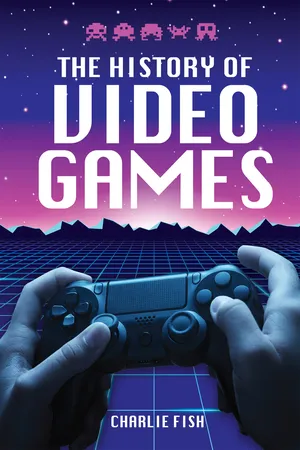![]()
Level 1
INTRODUCTION
While researching this book I’ve been blown away, again and again, by the scale of the video game industry. But, despite the immensity of this commercial juggernaut, one inspired individual with a quirky vision is so often able to create something new that captures the hearts of millions.
I was born in 1980, so video games have always been part of my life. I was the perfect age to be swept up by Nintendo’s ascendancy. When I was seven years old, living in Massachusetts, I couldn’t wait for school to finish so I could go to Danny’s house to play on his Nintendo Entertainment System.
At home, we had an IBM personal computer. Our floppy disks were still floppy. I bonded with my dad over Sierra On-Line’s graphic adventure games. Later, having moved to the UK, I filled notebooks with level designs for Lemmings and Commander Keen.
At the age of 13, my parents rewarded me for good exam results by buying me a Super Nintendo Entertainment System with Super Mario World – I could hardly believe the enormity of this gift. Meanwhile, on the PC, I was building urban utopias in SimCity 2000 and (to my parents’ distaste) blasting hell demons in Doom.
A level design for Lemmings from my exercise book, 1991. (Charlie Fish / CC BY 4.0)
SimCity 2000 (1993). (Maxis)
As I grew older, I made a conscious effort to spend less time playing video games, but never managed to resist their siren song for long. Every few years I bought the latest Nintendo console, and embraced the joy of gaming again for a few intense months. The advent of smartphones ensnared me into the habit of playing a quick game whenever I had a few spare minutes – and too often when I didn’t.
While writing this book, I was designing levels in Super Mario Maker 2, building civilizations in Through the Ages, and pretending to be a moody goose in Untitled Goose Game. Games are rewarding on a deep-seated psychological level. Just as rewarding are the stories behind them. I hope you’ll find these stories as fascinating as I do.
Untitled Goose Game (2019). (House House/Panic)
My dad’s first computer, a Sol-20 he bought in Toronto, Ontario in 1976. (Robin Sundt)
![]()
Level 2
PLATFORMS AND TECHNOLOGY
Video games are shaped by the technology of the day, and human creativity has always found ingenious ways of pushing the limitations of the hardware.
In 1990, British student Andy Davidson was playing around with a Casio graph-plotting calculator during a particularly boring maths lesson, when his friend said, ‘I bet you can’t make a game on that.’ He accepted the challenge. He made a basic artillery game, and soon ported it over to the school’s Amiga computer. The game was so popular, his teacher banned it. After working on it for four more years, he approached struggling game developers Team17, who snapped up the idea, and the hugely successful Worms franchise was born.
The idea behind Worms was not new. Artillery games, usually featuring two players taking turns to fire projectiles at each other on the screen, have a long heritage – a watershed example being Artillery Simulator released in 1980 for the Apple II home computer.
In fact, the world’s first video game was almost an artillery game. In 1947, American television pioneer Thomas T. Goldsmith, Jr. and Estle Ray Mann filed a patent for a ‘Cathode-ray tube amusement device’. The idea was to hook up an oscilloscope to a TV screen so the user could control the cathode-ray tube’s electron gun with dials, like an Etch-a-Sketch, and simulate firing a missile at a target. But the equipment was expensive and the device never hit the market.
There were a handful of early computers designed to play games, using a series of light bulbs for the display. First was the Nimatron, presented at the New York World’s Fair in April 1940, which played the mathematical strategy game Nim. The Nimatron was a success – about 50,000 people played it, and the computer won more than 90 per cent of the games. But in subsequent years it was largely forgotten, and a decade passed before another game-playing computer made a splash.
Total Wormage, precursor to the original Worms (1995). (Andy Davidson/Team 17/Ocean Software)
Patent for ‘Cathode-ray tube amusement device’, 25 January 1947. (Thomas Tolivan Goldsmith Jr. – US Patent 2455992, Public Domain)
The designer of the Nimatron, celebrated quantum physicist Edward Condon, considered it a ‘shameful’ failure that he did not exploit the full potential of his idea. (Manuscripts and Archives Division, The New York Public Library. ‘Westinghouse – Woman with electric brain machine’ The New York Public Library Digital Collections. 1935 – 1945)
At the Canadian National Exhibition in 1950, Bertie the Brain was a four-metre-tall monstrosity that emitted a loud buzz, and featured a visual display backlit with light bulbs. The machine was purpose-built to play noughts and crosses (a.k.a. tic-tac-toe), with several difficulty levels. It was very popular at the show and, by all accounts, hard to beat.
A similarly gargantuan machine was built in Britain a year later, also relying on circuitry made of vacuum tube valves, inspired by the Nimatron. The display still relied on light bulbs. Not until 1952 were the first software-based video games created that displayed visuals on an electronic screen – a draughts program and a noughts and crosses program, both made independently by British computer scientists.
American comedian Danny Kaye beats Bertie the Brain, after the difficulty was turned down a few notches (1950). (Bernard Hoffman/The LIFE Picture Collection/ Getty Images)
Arguably,...








